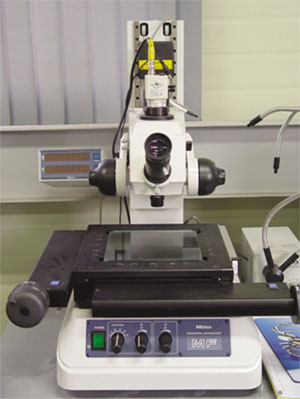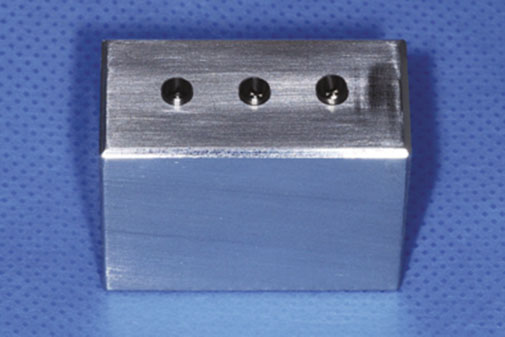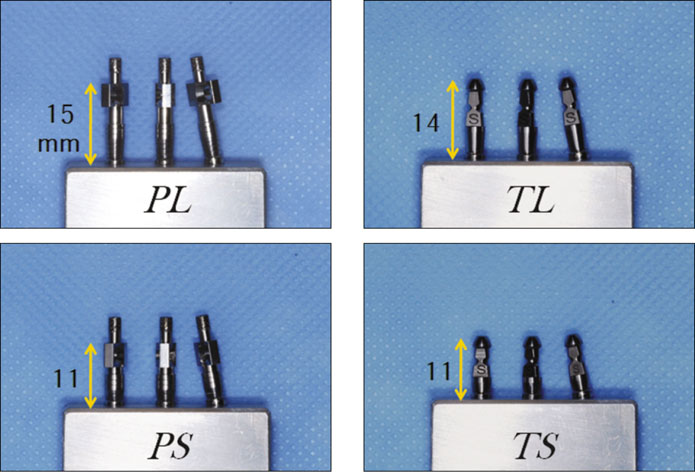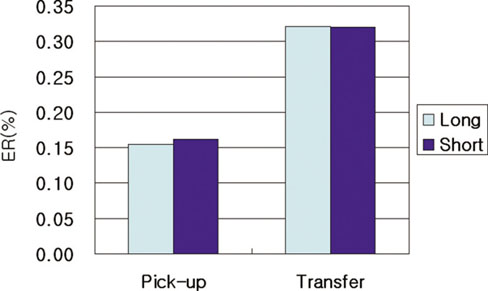J Adv Prosthodont.
2010 Dec;2(4):128-133. 10.4047/jap.2010.2.4.128.
Effect of impression coping and implant angulation on the accuracy of implant impressions: an in vitro study
- Affiliations
-
- 1Department of Prosthodontics, College of Dentistry, Chonbuk National University, Jeonju, Korea. sgahn@jbnu.ac.kr
- KMID: 1975187
- DOI: http://doi.org/10.4047/jap.2010.2.4.128
Abstract
- PURPOSE
The purpose of this study was to compare the accuracy of the implant master cast according to the type (pick-up, transfer) and the length (long, short) of the impression copings.
MATERIALS AND METHODS
The metal master cast was fabricated with three internal connection type implant analogs (Osstem GS III analog), embedded parallel and with 10degrees of mesial angulation to the center analog. Four types of impression coping were prepared with different combinations of types (transfer, pick-up) and lengths (long, short) of the coping. The impressions were made using vinyl polysiloxane (one step, heavy + light body) with an individual tray, and 10 impressions were made for each group. Eventually, 40 experimental casts were produced. Then, the difference in the distance between the master cast and the experimental cast were measured, and the error rate was determined. The analysis of variance was performed using the SPSS (v 12.0) program (alpha = .05), and the statistical significance was set at P < .05.
RESULTS
The ANOVA showed that the pick-up type impression coping exhibited a significantly lower error rate than the transfer type. However, no significant difference was observed with respect to the length of the impression coping. Additionally, no significant difference was observed between the parallel and mesial angulated groups.
CONCLUSION
Within the limitations of this study, the pick-up type impression coping exhibited a more accurate implant master cast than the transfer type in parallel group. The accuracy of the implant master cast did not differ for different lengths of impression coping of at least 11 mm. Additionally, the accuracy of the implant cast was not different for the parallel and 10degrees mesial angulated groups.
MeSH Terms
Figure
Reference
-
1. Adell R, Lekholm U, Rockler B, Brånemark PI. A 15-year study of osseointegrated implants in the treatment of the edentulous jaw. Int J Oral Surg. 1981. 10:387–416.2. Brånemark PI. Osseointegration and its experimental background. J Prosthet Dent. 1983. 50:399–410.3. Rangert B, Jemt T, Jörneus L. Forces and moments on Brånemark implants. Int J Oral Maxillofac Implants. 1989. 4:241–247.4. Kan JY, Rungcharassaeng K, Bohsali K, Goodacre CJ, Lang BR. Clinical methods for evaluating implant framework fit. J Prosthet Dent. 1999. 81:7–13.5. Carr AB, Gerard DA, Larsen PE. The response of bone in primates around unloaded dental implants supporting prostheses with different levels of fit. J Prosthet Dent. 1996. 76:500–509.6. Jemt T, Book K. Prosthesis misfit and marginal bone loss in edentulous implant patients. Int J Oral Maxillofac Implants. 1996. 11:620–625.7. Michaels GC, Carr AB, Larsen PE. Effect of prosthetic superstructure accuracy on the osteointegrated implant bone interface. Oral Surg Oral Med Oral Pathol Oral Radiol Endod. 1997. 83:198–205.8. Jemt T, Lekholm U, Johansson CB. Bone response to implant-supported frameworks with differing degrees of misfit preload: in vivo study in rabbits. Clin Implant Dent Relat Res. 2000. 2:129–137.9. Burns J, Palmer R, Howe L, Wilson R. Accuracy of open tray implant impressions: an in vitro comparison of stock versus custom trays. J Prosthet Dent. 2003. 89:250–255.10. Lee H, So JS, Hochstedler JL, Ercoli C. The accuracy of implant impressions: a systematic review. J Prosthet Dent. 2008. 100:285–291.11. Choi JH, Lim YJ, Yim SH, Kim CW. Evaluation of the accuracy of implant-level impression techniques for internal-connection implant prostheses in parallel and divergent models. Int J Oral Maxillofac Implants. 2007. 22:761–768.12. Lee H, Ercoli C, Funkenbusch PD, Feng C. Effect of subgingival depth of implant placement on the dimensional accuracy of the implant impression: an in vitro study. J Prosthet Dent. 2008. 99:107–113.13. Barrett MG, de Rijk WG, Burgess JO. The accuracy of six impression techniques for osseointegrated implants. J Prosthodont. 1993. 2:75–82.14. Wee AG. Comparison of impression materials for direct multi-implant impressions. J Prosthet Dent. 2000. 83:323–331.15. Wenz HJ, Hertrampf K. Accuracy of impressions and casts using different implant impression techniques in a multi-implant system with an internal hex connection. Int J Oral Maxillofac Implants. 2008. 23:39–47.16. Assuncao WG, Filho HG, Zaniquelli O. Evaluation of transfer impressions for osseointegrated implants at various angulations. Implant Dent. 2004. 13:358–366.17. Carr AB, Master J. The accuracy of implant verification casts compared with casts produced from a rigid transfer coping technique. J Prosthodont. 1996. 5:248–252.18. Carr AB. Comparison of impression techniques for a five-implant mandibular model. Int J Oral Maxillofac Implants. 1991. 6:448–455.19. Assif D, Fenton A, Zarb G, Schmitt A. Comparative accuracy of implant impression procedures. Int J Periodontics Restorative Dent. 1992. 12:112–121.20. Phillips KM, Nicholls JI, Ma T, Rubenstein J. The accuracy of three implant impression techniques: A three-dimensional analysis. Int J Oral Maxillofac Implants. 1994. 9:533–540.21. Rodney J, Johansen R, Harris W. Dimensional accuracy of two implant impression copings. J Dent Res. 1991. 70:385.22. Conrad HJ, Pesun IJ, DeLong R, Hodges JS. Accuracy of two impression techniques with angulated implants. J Prosthet Dent. 2007. 97:349–356.23. Ma T, Nicholls JI, Rubenstein JE. Tolerance measurements of various implant components. Int J Oral Maxillofac Implants. 1997. 12:371–375.24. Rubenstein JE, Ma T. Comparison of interface relationships between implant components for laser-welded titanium frameworks and standard cast frameworks. Int J Oral Maxillofac Implants. 1999. 14:491–495.
- Full Text Links
- Actions
-
Cited
- CITED
-
- Close
- Share
- Similar articles
-
- Comparison of the accuracy of implant digital impression coping
- Comparative accuracy of new implant impression technique using abutments as impression copings with an angulated implant model
- Comparison of accuracy between digital and conventional implant impressions: two and three dimensional evaluations
- Comparison of 3D accuracy of three different digital intraoral scanners in full-arch implant impressions
- Accuracy of a proposed implant impression technique using abutments and metal framework







